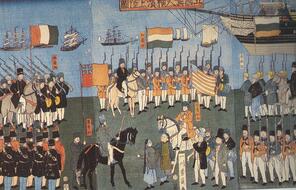1853: United States Commodore Matthew Perry’s “black ships’ arrive in Edo Bay.
1854: Perry returns and negotiates Treaty of Kanagawa. First treaty signed between Japan and the United States. Treaty is instrumental in dismantling the two-century-old policy of isolation.
1856: The shogunate signs Harris Treaty between U.S. and Japan opening up eight Japanese ports to American merchants and giving the U.S. “most favored nation” trade status.
1860: First Japanese mission is sent to the United States.
1867: Keiki, the last Tokugawa shogun, resigns, ending the Tokugawa shogunate.
1868: Meiji period begins and the Charter Oath is written. Shōgunate replaced with central power, old samurai class eliminated, primary education and universal military service for men becomes compulsory. Edo is renamed Tokyo. Capital moved from Kyoto to Tokyo the following year.
1871: Iwakura Mission departs for the West. Aim is to observe and learn about western models and methods of civil governance.
1889: Meiji Constitution is promulgated
1890: First Diet convened. The Imperial Rescript on Education is issued.
1894: Sino-Japanese War. Japan is victorious and asserts its first gains as an imperial power. Korea is “turned over” (colonized) to Japan and China cedes Taiwan to Japan
1904 -1905: Russo-Japanese War. Japan is victorious against Czarist Russia.
1907: The United States and Japan reach a Gentleman’s Agreement stating that the United States would neither impose nor enforce restrictions on Japanese immigration and Japan would not allow further emigration to the United States
1910: Korea is annexed.
1912: Emperor Meiji dies. His eldest son, Yoshihito, ascends to throne. Taisho period begins
1914-1918: World War I. Japan is allied with the U.S. and Great Britain.
1919: Japan fails to get Racial Equality clause inserted into the covenant of the League of Nations.
1923: Great Kantō Earthquake - deadliest in Japan’s history. Cities such as Tokyo re-designed after being leveled.
1924: Johnson-Reed Immigration Act signed barring all Japanese entrance to the United States.
1925: Universal male suffrage instituted. The electorate increases fivefold.
Late 1920s: Extreme nationalism takes hold in Japan. Emphasizes preservation of traditional Japanese values and rejection of “Western” influence.
1930: London Naval Treaty signed.
1931: Manchuria is invaded and occupied.
1932: Japan renames Manchuria Manchukuo and installs a puppet regimes lead by Emperor Puyi (The Last Emperor.)
1932: Japanese prime minister is assassinated by ultra-nationalists. Military holds increasing influence in country.
1933: Japan withdraws from League of Nations after condemnation by the international community regarding their occupation of Manchuria and est. of Manchukuo.
1936: November 25th: Japan sign the Anti-Comintern Pact with Nazi Germany. It concludes a similar agreement with Italy in 1937.
1937: July 7th: Marco Polo Bridge Incident in China initiates invasion of mainland China. Battle of Shanghai occurs from mid August-November followed by the occupation of Beijing and the then capital city, Nanjing.
December 13, 1937: Nanjing occupied. Height of mass violence lasts until February 1938. Nanjing remains an occupied city throughout World War II in China.
1939: Outbreak of World War II in Europe. With the fall of France to Nazi Germany in 1940, Japan moves to occupy French Indo-China
1940: Axis alliance among Rome, Berlin and Tokyo is formed.
1941: Japan attack on the U.S. Pacific fleet at Pearl Harbor, Hawaii. The US and its main allies declare war on Japan the following day.
1942: Japan occupy the Philippines, Dutch East Indies, Burma and Malaya. In June, U.S. aircraft carriers defeat the Japanese at the Battle of Midway. The U.S. begins a strategy of "'island-hopping", cutting the Japanese support lines as its forces advance.
1944: U.S. forces are near enough to Japan to start large scale bombing raids on Japanese cities.
1945: U.S. planes drop two atomic bombs, one on Hiroshima (6 August), the second on Nagasaki (9 August). Emperor Hirohito surrenders and relinquishes his divine status. Japan is placed under U.S. military government on August 15, 1945. All Japanese military and naval forces are disbanded.
1947: A new constitution with parliamentary system and all adults eligible to vote. Japan renounces war, pledges not to maintain land, sea or air forces for that purpose. The emperor is granted ceremonial status.
1951: Japan signs peace treaty with the U.S. and other nations in San Japan ending SCAP occupation of Japan. 1
- 1This timeline is not comprehensive but dates and events selected align with the content explored in Facing History & Ourselves’ The Nanjing Atrocities: Crimes of War. Adapted Sources of Japanese Tradition, edited by Wm. Theodore de Bary, Ryusaku Tsunoda, and Donald Keene, Second Edition, Vol. 2 (New York: Columbia University Press, 2005) pp. xli-xlii, Japan–Timeline of Historical Periods, accessed March 7, 2014 and Japan profile – Timeline, accessed April 1, 2014.











